ONE
ON SPIRIT, SOUL, AND CONSCIOUSNESS IN GENERAL
As already suggested in the introduction, our concern in this book is to consider the issue of spiritual initiation as one directly related to the question of evolution. However, unlike in Darwinism, our focus is specifically on consciousness. This is on the grounds that it is adaptable consciousness that gives rise to forms throughout Nature, not forms to consciousness. Having said as much, however, we need to explain why and how that should be so before we go any further, so that the reader is clear on the issue from the outset. We can then go into further detail concerning initiation itself, on the basis of established parameters.
Perhaps the first thing that we ought to deal with is the ancient idea that the omniverse (Space) exists within the oceanic (but nevertheless sevenfold) field of consciousness of an Intelligence of which the human mind can have no faint conception, but which many still misconceive of as “God.” This is the logical basis of the paradox—already recognized by the more far-seeing modern scientists of our time in various fields—that the omniverse and its major and minor forms are all derived from Chaos but are nevertheless coherently maintained by consistent, patterned Order.
The ancient Egyptians recognized the principle of consistent Order, ascribing it to the wisdom of the metaphorical goddess Ma’at (see fig. 1.1). Ma’at is a slight variation on the Sanskrit Mahat, itself signifying the Kosmic (or Universal) Mind and memory, symbolized in Egypt by her husband-god Tehuti. However, as such consistency can only be the product of intelligence (and not a product of mere chance, as Darwinian extremists would have it), it follows that Universal Nature itself must possess a vast spectrum of intelligence, perhaps involving what Jung called the “collective unconscious.”1 From this viewpoint, what we call “evolution” takes on a much greater sequential perspective than provided by mere Darwinism, which deals only with objective local effects.
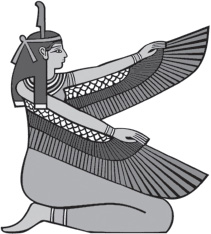
Fig. 1.1. The Egyptian goddess Ma’at
What we call “initiation” itself follows suit. It implies a progressive sequence of subjective development, specifically concerned with consciousness, of which Mind is but a projection. Hence we may suggest that “inner reality” has a definitely structured or hermeneutic nature, which relates the human microcosm to the macrocosmic Logos or celestial Intelligence within whose manifest Being all solar and planetary Nature is contained. This correlation is as depicted in fig. 1.2, which endeavors graphically to illustrate the concentric nature of consciousness as a dynamic sequence of states, as well as mentioning some of the entities contained within or controlling each greater and lesser field/state of existence. We will deal with the latter in greater detail a little later on when we will refer back to this same illustration.
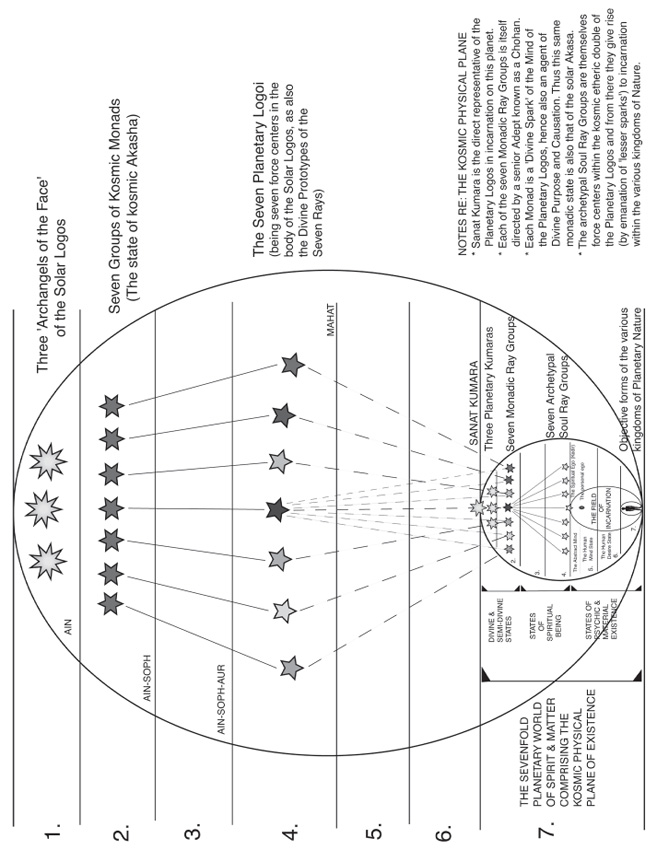
Fig. 1.2. The hierarchically organized, sevenfold kosmic scheme of Creation
Now, before we start to discuss initiation itself in any detail, we need first to consider those background structures and potentials of consciousness as universal principles, and how they are developed from a fundamental state of generalized awareness in Nature. It is as yet impossible to do this from a purely scientific viewpoint, simply because our modern Western science does not begin to understand what awareness and consciousness actually are or even might be, other than in terms of effects caused by a possibly symbiotic collision of neurons. Thus mainstream biophysics and biochemistry are as yet unprepared to face the idea and practical effect of consciousness as the intelligently organized awareness inherent in matter. However, functional awareness is an attribute of all organisms, as well as being qualitatively organized and entirely subjective in its causal origins.
NEW AGE AND SCIENTIFIC CONCEPTS OF SUBTLE STRUCTURES
A consideration of some of the modern approaches to the structure of consciousness may help to provide a helpful context for our exploration. The New Age approach to the subtle worlds of existence behind objective reality is quite varied. This is despite a number of commonly accepted principles such as that Earth life is intended as a “school” for the learning of higher values and perceptions through rejection of materialistic values and paradigms; also that humanity has to learn to live in harmony with Nature rather than merely trying to exploit her, so as to produce the idealized world on which modern “holism” is based. Parallel to this, many neopagan and shamanic views appear curiously materialistic because they see everything in Nature as sacredly derived from the “World’s Mother.” But in so doing they seem largely confused as to the distinction between the higher, spiritual world scheme and the merely psychic nature of the objective one. They also reject the objective or scientific approach in favor of learning what they see as a mystically instinctive perception of Nature’s subtly adaptive capacities. This, however, is fundamentally regressive. It is vastly different from the concept of developing a truly spiritual intuition in which the perception of other, far higher states of being becomes accessible to an expansively evolving human consciousness.
In direct contrast, we have the neo-gnostic “escapist” view, which has been derived from many and varied misconceptions of Alexandrian “New Age” thought two thousand years ago; it sees the objective world as the disastrous result of mistakes made in the spiritual world by highly intelligent Beings “who should have known better.” However, we will not go into this here as it is dealt with in far greater detail in the later chapters of the book. Nevertheless, it is fascinating to contrast it with the modern Sethian approach in relation to which Wouter Hanegraaff (professor of Western Esotericism at the University of Amsterdam) curiously describes Jane Roberts (its founder) as “the Muhammad of New Age religion and Seth as its angel Gabriel.”2 The Sethian approach basically takes the view that the Eastern focus on the Absolute and the eventual nirvana of absorption into it is a complete waste of time. Hence one should instead be directing oneself to learn all about the spiritual creative principle so that one can become a co-creator with God and thus have a much more interesting eternity to face. However, this is based on a clear misconception of Eastern thought, which we shall also explain in greater detail later on.
Many of the ideas within modern science that are concerned with arriving at a unified understanding of consciousness and the universe are related with what is often called the “holographic paradigm.” Perhaps the best known of those ideas based on holographic structures are those of neuroscientist Karl Pribram (whose concern, however, is merely the brain function) and the theoretical physicist David Bohm. The central idea with these two, however, is that “the form and structure of the original object are enfolded within each region of the photographic [or visual] record and can in turn be unfolded from each region.” Hence Bohm’s suggestion that here lies a causal, “implicate order,” quite distinct from the merely mechanistic order that orthodox science presupposes.3 There are, nevertheless, various presuppositions associated with this general concept that are in fact based on a merely more subtle but psychic background activity, which is not truly spiritual at all.
Another popular modern concept is that formulated by Ilya Prigogine, who—in a manner interestingly parallel to that of the Sethians—takes the view that the “ever becoming” nature and character of the universe is far more important than the issue of its underlying “being.” He is thus highly critical of the concept of eternal laws suggesting a fundamental cosmic harmony.4 But this approach in turn falls prey to the objective world view that Plato referred to as the “ever changing” or “different”—hence unreal, because it is ever-generating new prototypes and their offshoots—instead of trying to understand the world of spiritual archetypes that provides the truly causal reality behind everything that exists in objective and even subtle Nature.
SPIRITUALITY AND EVOLUTION
This is an area where few seem to want to tread because of associated uncertainties. The work of two modern researchers in this general field provides us with a clear indication as to where and why modern science itself has gone astray. First of all, the biologist Dr. Richard Dawkins—known worldwide for his much televised scientific materialism, atheism, and public evangelism on behalf of neo-Darwinism—has nailed his colors to the mast on the basis of a mere assumption. That completely unfounded and poorly researched assumption involves the idea that the views of Creationists and Darwinists are the only alternatives available to consider the problem of human biological causation and subsequent development; hence that there is no such thing as a spiritual state of existence. He consequently sees the (equally prejudiced) Creationist approach as baseless and founded on mere superstition. That his atheistic view is itself based on myopic prejudice and lack of awareness of other available and quite well known perspectives should become very apparent well before the end of this book. To some extent, however, I have already dealt with some of the related issues in my previous book, The Rise and Fall of Atlantis.*4
The second person to base his whole theory on a basically flawed assumption is the also internationally known and really remarkable “mind-smith” Ken Wilber. His area of research lies not in biogenetics but in the combined fields of physics, psychology, and parapsychology, where he has become particularly well known for his approach to “the integral theory of everything.” This involves the attempt to relate everything of a subjective nature in human experience to everything of a physical nature by way of what we might see as a web of “intellectual artifacts.” Just as Dawkins sees everything in his field from only two points of view, Wilber tends to do rather the same—but much more interestingly—from the angle of “constructive post-modernism.” Even so, his criticism of the holographic paradigm and of the supposition that there are close connections between science and mysticism represents a lone view within the New Age movement.
However, despite his many valid psychological insights, Wilber’s own viewpoint is itself surprisingly anthropocentric and restrictive. For him, despite the extraordinary extent of his own subjective experience in the fields of transpersonal psychology and mysticism (which latter he curiously and mistakenly associates not only with religion but also with metaphysics), there is essentially only the physical world and the spiritual world. These are then holistically connected by a relating mass and variety of what he calls “integrals,” seemingly derived from his third factor—Mind. However, much of the latter, as described and explained by him in his immensely complex books, involves (to the esotericist) quite definitely no direct connection with the spiritual world at all. They too are rather associated with an intermediate, merely compound psychic state of existence, which science does not (yet) recognize and to which most New Age groups pay curiously little if any attention, because they do not choose to understand its distinctive nature either.
As regards the view of science itself, we hear in Wilber’s own words that “modern physics neither proves nor disproves, neither supports nor refutes, a mystical-spiritual world view,” this apparently being on the altogether illogical basis that “If today’s physics supports mysticism, what happens when tomorrow’s physics replaces it? Does mysticism then fall also?”5 Curiously, he does not see this as a complete non sequitur, despite the fact that all such interpretations of perception, in whatever field of concern, are themselves based on constant and inevitable mutation.
Wilber’s further suggestion that all of the greatest physicists of modern times—Einstein, Schrödinger, Heisenberg, Bohr, Eddington, Pauli, de Broglie, Jeans, and Planck—are “virtually unanimous in declaring that modern physics offers no positive support whatsoever for mysticism or transcendentalism of any variety (and yet they were all mystics of one sort or another . . .”6 fails to acknowledge that for them actually to have done so in public would have led to an early end of their scientific careers. In fact, Pauli (like Jung) believed that psyche and matter were composed of the same substance.7 Wilber also fails to mention that Eddington, for example, long before Koestler, had suggested that elemental particles could be intelligent matter. This was a view later pursued not only by physicist D. F. Lawden, who held that “the continuity of Nature entails that consciousness or intelligence be a universal property of matter,” but also by astronomer V. A. Firsoff, who was of the opinion that “Intelligence is an entity or universal interaction of the same nature as electricity or gravity.”8 Other well known scientists like Einstein (see fig. 1.3) have expressed similar (actually highly occult) views. We might thus suggest that the outwardly apparent result (conditioned by its environment) does not necessarily coincide with the truly causal hypothesis. Wilber also pays no attention to the fact of occult science, rather than mere mystical experience. These two will be defined in accompanying detail in the next section so that we can better understand where and why there is a common failure to understand real connections.
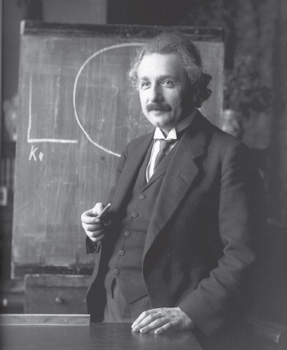
Fig. 1.3. Albert Einstein
There is no intention here of criticizing Wilber specifically. However, he is undoubtedly one of the best and foremost examples of our times of someone who started out with the most beneficent combination of a first rate academic intellect in tandem with a mystic nature, who then rejected the former; then, despite (or perhaps because of) several forced mystic or other experiences brought about by his own asceticism or other personal experience, he has become progressively mired in his own subsequently attempted intellectualization of the objective and subjective worlds of human experience. His descriptions of the hermeneutic structures of consciousness—while acknowledging the existence of and necessity for progressive planes or states of being—lack any real metaphysical understanding of their essential natures or interactive dynamics. That is largely because—in his attempt to rationalize the duality of objectivity and subjectivity—he mistakenly tries to shoehorn ancient subjective perceptions into modern psychological and scientific concepts. However, he does so without the use of true metaphysics, the latter itself being a very far cry from the so-called metaphysics of medieval or even modern theologians. In short, he has attempted to “take Heaven by storm” in purely theoretical terms, by progressing the Path of spiritual initiation in an altogether unnatural, back-to-front manner. In addition, he completely fails to understand the practical difference between the esoteric and the occult—which we will now deal with in greater detail.
ESOTERIC PHILOSOPHY AND OCCULT SCIENCE
Like nearly all modern scientists, Wilber tends rather simplistically to follow the neo-Darwinian line by assuming that consciousness is merely a product of historical and biological experience. Esoteric philosophy on the other hand states quite unequivocally that consciousness precedes the development of its own objective organs of perception. For most scientists, this appears nonsensical. How can there be percipient faculty without an objective organ? The Cartesian answer to this would be to state that mind and matter are quite separate, thereby generating that attitude that distinguishes between quantum physics and classical physics. The former is seen as dealing only with the subatomic world, while the latter deals only with so-called “objective reality.” However, quantum physics has itself shown us that the objectively visible world is in fact an illusion and this has in turn led to the development of a rather newer and more inclusive (but still incomplete) view of what consciousness itself might perhaps be all about.
This view, as expressed by the scientist Amit Goswami in his books The Self-Aware Universe and The Visionary Window, involves what is called “monistic idealism.” It posits the concept that ideas and their associated consciousness are considered to be the basic elements of reality and that matter is secondary even though, paradoxically, consciousness is itself composed of matter.9 Thus, whereas mainstream science of the last two hundred years or so has viewed mind and consciousness as epiphenomena of matter, monistic idealism takes the reverse view. According to monistic idealism, forms derived from matter are themselves the epiphenomena of consciousness. Hence Goswami quotes his fellow scientist Henry Stapp who interestingly suggests that the message of quantum nonlocality is that the fundamental process of Nature lies outside space-time but generates events that can be located in space-time,10 although he does not add quite how this might be so.
Although this overall view appears to coincide with the way in which esoteric philosophy sees the process, it is only partially correct, because it fails to explain or suggest the real basis of both perceived and perceptual identity. Because of its scientific belief in the modern anthropic principle (the idea that the universe evolves toward life and sentience11 or for the purpose of creating sentient beings12) it also fails to explain, or even to examine, the most fundamental axiom of esoteric and occult philosophy: that there is not, nor ever could be, any such thing as dead matter in the first place. This concept (that “dead” matter exists) is in fact a bizarre product of nineteenth and twentieth century reductionist thinking never wholly accepted, however, by the world’s leading scientific minds. In practical terms, all existence contains and expresses (to a greater or lesser extent) the three basic universal principles of Being, Knowing, and Doing, or Livingness, Sensory Capacity, and Intelligent Adaptability.
This takes us back to the issue of the important distinction between esotericism and occultism (occult science to be more precise). Esotericism involves the study of the essential nature and interrelationships between all aspects or expressions of existence, whereas occultism—whether conscious or not—concerns itself with understanding the associated energies and forces of the omniverse and the manner of their natural implementation, hence with the law of cause and effect (referred to in Sanskrit as karma). It is for this reason that esoteric philosophy always works “from the universal to the particular,” whereas the accrual of purely intellectual knowledge or personal experience works in precisely the opposite direction, thereby resulting in natural friction between the two. We shall return to this same subject frequently throughout the book.
SO WHAT EXACTLY IS MATTER?
What the ancient wisdom tradition has always stated and what modern science has confirmed for us is that energy and matter are but varying phases of the same essential phenomenon (hence E = mc2). In practical terms, energy-matter is infinitely variable in expression while paradoxically being composed of nothingness; yet it is the source of all life and objectivity. How can this be so? Well, esoteric philosophy—as symbolically indicated by the Great Seal of Solomon (see fig. 1.4)—answers this by suggesting that energy and matter are but the two objectively complementary faces of the one Life or Universal Spirit that pervades the omniverse, there being nothing else in the whole field of existence. But esoteric philosophy goes a step further in suggesting that the variability of self-expression is due to the Spirit’s essentially qualitative nature. However, as the spectrum of quality is itself infinite, so the forms of self-expression must inevitably, in parallel, involve a systematic degree of repetition, although themselves differing in quality.
The essence of what is being suggested here then is that this infinitely qualitative spectrum of being or existence necessitates all qualities existing side by side, yet with each somehow retaining an independence of state. Thus a being of a particularly refined state could pass through a much denser state or series of states without even being aware of them as such. In practical terms, because matter is essentially invisible, esotericism refers to it as the “universal ether.” Hence it is possible to have a kosmic or a celestial ether, a systemic ether (related to the life of our solar system), and a planetary ether. This trinity of existence is the compound that we shall adopt in this book. Hence also we shall find ourselves referring to kosmic beings, solar or systemic beings, and planetary beings, all of these being “spirits,” considered either individually or, as we shall see shortly, as hierarchically organized groups forming a parallel spectrum of fields of consciousness.
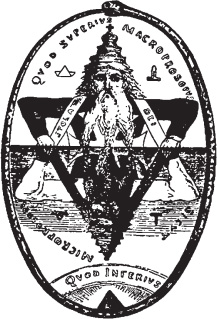
Fig. 1.4. The Great Seal/Symbol of Solomon, from Eliphas Levi’s The History of Magic
SO WHAT IS CONSCIOUSNESS?
Some of today’s more open-minded scientists may intend to explain consciousness (hence also matter) in terms of scientific quantum theory, but their approach in doing so usually fails to consider the rationale behind the spectrum of Universal Being, of which consciousness is itself merely one of two aspectual expressions. Consciousness involves sentience, but sentience itself involves a preceding foundation of being and generalized awareness. So it is the latter that logically needs to be considered first. In fact, the esotericist explains this by positing Universal Being—that is, Life itself—as the true, qualitatively organized foundation behind all existence. Hence the use of the ancient Hermetic axiom “as above, so below” to describe its repetitively complementary nature—in terms of underlying principles of expression.
The esotericist uses this axiom to describe how consciousness involves a subtle duality of percipience derived from the progressive limitation of Universal Awareness into a sequence of concentrically organized fields of limitation, as we saw earlier in fig. 1.2. That is to say, consciousness arises through progressive macrocosmic emanation. It does so through the Macrocosm projecting a partial, germinal aspect of itself (as Mind) into a lower field of existence in order to produce a form of phenomenal self-expression (such as a planet or a kingdom of Nature). That projected aspect involves a group (or groups) of lesser beings or entities (commonly referred to in esotericism as “sparks”) whose task it is to generate that self-expression as accurately as possible before returning to their Source to report on the effectiveness of what they have achieved. Hence there inevitably occurs a simultaneously higher and lower consciousness arising out of this experience. This results from the intelligence of the emanated group eventually recognizing its own experiential field as one of subjective self-limitation. The same group then progressively realizes that this field can be breached by expansive movement back into the already existing and larger parent field of consciousness that was its own Source (involving a greater reality) in which another, far more advanced (and far more subtle) degree of intelligence already exists.
The “monistic idealism” of Goswami derives from the seemingly curious theoretical concept formed by quantum scientists that the collapse of the quantum wave to produce a visual actuality is based on the intervention of an embodied consciousness, hence that consciousness has no material basis.13 However, esoteric and occult philosophy state quite categorically that Life itself is the basis of all matter and that—as there is nothing other than Life in the omniverse—everything, including both awareness and consciousness, has a homogeneously “material” basis in essence, albeit posing as an infinite spectrum of qualitatively different light in outward expression.
It is here then, in relating microcosm to Macrocosm, that we discover another distinction between esoteric philosophy and occult science. Esoteric philosophy deals not only with perception as to the widely varying interrelationships between subtle organisms and beings at every possible level of objective or subjective existence but also their causes. Occult science, however, deals very specifically not only with the characteristic nature of all the energies and forces in the universe—again whether objective or subjective—but also the techniques by which they work or can be controlled. The former, while not exactly theoretical, does not concern itself with quite the practical, “hands-on” involvement of the latter. This distinction is highly important and needs to be kept in mind, as does the fact that esotericism and occultism, if properly practiced, work hand in glove with each other as the expression of intelligent purpose. In reality, they cannot be approached from a merely academic or intellectual viewpoint, because the intellect only succeeds in cloaking and disguising them.
MIND, INTELLIGENCE, SPIRIT, AND SOUL
One of the most fundamental aphorisms for those “on the Path” (of spiritual evolution) is that “the mind is the great slayer of the Real”—hence the direction: “Let the disciple slay the slayer.”14 A second most important principle is that intelligence and mind are quite separate. True intelligence actually uses the mind (involving the emanation of a field of knowledge) by working “from above downward,” not “from below upward.” The range of modern human intelligence is considerable but the whole process of evolution is actually based upon persistently necessary self-sacrifice (by the higher nature) of that which is the very basis of past experience, when no longer of real use. However, many are those who mistakenly seem to believe that one can eat one’s cake and still have it. They fail to recognize the fundamentally important occult difference between living “causal essence” and past “experiential effect.” As a result, they personalize all experience rather than realizing that they are, in a very real sense, merely observers of a constantly changing spectrum of existence that ever surrounds them.
One other highly important issue that needs to be considered here—although it is not recognized by academics, scientists, or theologians (or journalists) in general—is that in considering esoteric and occult philosophy, the very first thing to be understood is the entirely rational distinction between spirit and soul. Without this recognition, there will be no real understanding of anything else.
First of all, in acknowledging the ancient metaphysical concept that there is but one Life and one Intelligence in the ocean of the omniverse (there being nothing else in existence), it behooves us to recognize that all substance and energy comprise, in essence, what we rather blandly call “spirit.” That fluidic spirit, however, is made up of a qualitative infinity of huge and tiny monadic “sparks,” or germs of living awareness, each with its own innate potential intelligence. It is these that periodically separate and recombine in a multitude of different ways to produce those temporarily differentiated states of being and consciousness that we call “souls,” which in turn give rise to “planes” or “states” of matter, involving kosmic, solar, and planetary systems, plus all the various kingdoms of Nature within them.
Soul, on the other hand, consists of the coordination of a huge group of spirits coming together through a common sense of identity (or “selfhood”) and thereby forming the periphery of a field of isolated existence that then acts as a space within which creation/incarnation can take place. This periphery is akin to the “brane” of the quantum physicist and the “event horizon” of the astrophysicist.
Each soul is itself but an expression of a hierarchically greater and more knowledgeable soul, which, in turn, is itself a cellular expression of something far greater still that nevertheless embodies the same principle. (Please refer again to fig. 1.2.) In other words, each soul entity is but a partial emanation or projection of a far greater and more powerful parent soul, an all-soul or “Oversoul” as the Greek philosopher Plotinus (204–270 CE) put it.15 (See fig. 1.5.)
Thus the Oversoul of the Earth is itself a cell derived from the yet greater Oversoul of our solar system. The Oversoul of our solar system is in turn a cell derived from the vastly greater Oversoul that contains the stellar nebula within which our solar system exists, and so on. In each case, the soul in question is composed of groups of spirits of a particular quality and force, and it is their composite range of faculty and power that then characterizes them, together, as a greater or lesser form of individuality. Similarly, the human psycho-spiritual organism involves a parallel concentricity, as illustrated (but not to scale) in fig. 1.6, which depicts the three human soul bodies: terrestrial, causal, and spiritual.
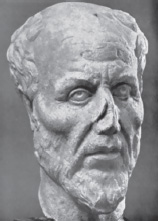
Fig. 1.5. Plotinus
The derivation and nature of the three human soul bodies is of fundamental importance to our esoteric considerations, and we shall deal with related issues in greater detail in chapter 2. For the moment, however, let us define the Spiritual Soul as the offspring of the Oversoul of our solar system, embodying its instinctively intelligent (hence rational) nature. The terrestrial or “astral” soul is correspondingly the offspring of our planetary Oversoul, embodying its natural instincts—those of the animal and plant kingdoms in particular—which is why it is also known as the “irrational” soul. The intermediate Causal Soul is, however, semi-spiritual and purely human in nature, hence human consciousness acting as a reasoning bridge between the other two. However, let us now spend a moment considering the issue of what the soul body sets out to contain and generate in terms of form, remembering that it follows the “as above, so below” principle. In other words, the greater gives rise to the lesser, not the other way around.
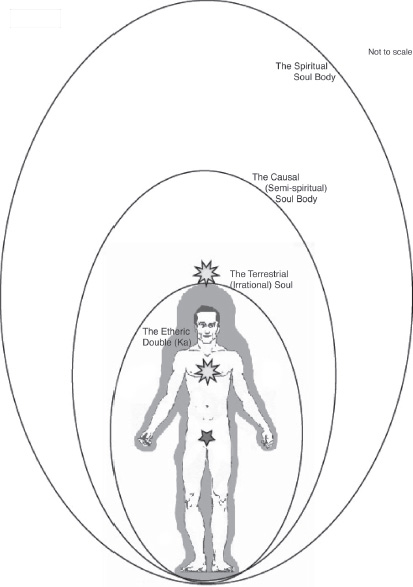
Fig. 1.6. The three souls of the human
Each soul coming into a fresh cycle of (re)incarnation seeks to contain lesser matter of a particular quality, which it then conditions with its own nature and (temporarily) uses as its servant. For example, the terrestrial (or “astral”) soul borrows such matter from the reservoir of substance maintained by the planet. This then becomes its physical elemental “shadow” or “double” (the Egyptian ka), which generates a corresponding organic body form out of itself. This “etheric double”*5 (see again fig. 1.6) thus becomes a sort of battery-transceiver (constantly recharged by the vital electrical tension of the soul), which maintains and sustains the coherence and functionality of the physical body. Like the soul organism, it too is composed of light, although not of so subtle a nature.
However, such is the symbiotic closeness of the relationship that develops between the terrestrial soul nature, the elemental “double,” and the physical body form and its processes that they appear to be one. Consequently, once the terrestrial soul has managed to bring about this inward coordination (in early childhood), it then begins to pursue a parallel outward process of elemental coordination as well, thereby progressively developing what we regard as our subjective nature—comprising the emotions and the lower mind. This development leads to the sense of “self.” Hence we may suggest that the extraverted projection of soul influence is itself the very basis of selfhood. Self is actually founded in the soul nature.
One often hears the suggestion that the soul resides “in the body.” This is technically wrong, as it is the soul—held in place by the Mind principle, acting as a restraining sheath16—that contains the physical body form, which it generates within and from the massed matter of the etheric double, as we shall see in more detail later on.17 It is again the soul that, via the chakra system,*6 emanates its own psycho-spiritual nature, thereby generating its “anchorage” in the etheric double. From the chakras are then produced those microcosmic organisms known to us as the organic cells that, in the form of flesh and blood, make up the different limbs and organs of the physical body.
However, the terrestrial soul has no capacity for entirely self-engendered function. For that, it relies upon the directing influence of the mind, which (emanated by the higher soul—that is, the Causal Soul) contains and controls it. The union of the mind sheath and the terrestrial soul generates an entity that has a direct parallel to what in modern quantum science is called an “event horizon.” It is within this that all knowledge or information is found in a two-dimensional state that, upon emanation, gives rise to three-dimensional forms. Quantum theory, however, makes the error of suggesting (in its current paradigm) that, due to its highly magnetic nature, light or other matter never escapes from within this entity. It does indeed do so, for it ultimately (following the evolutionary process) becomes luminescent and then colorfully radiant, by virtue of liberation of its animating essence.
THE SOUL PRINCIPLE
An increasing number of scientists today are already toying with the idea that the animating consciousness of the human organism originates “outside the body.” That has occurred purely because the observed physical processes more and more clearly confirm that consciousness cannot be a phenomenon with a purely physical cause. The question then arises, “What exactly is the outer organism that might contain or generate consciousness?” Fortunately, the (at least hypothetical) answer to this has actually been known for many past millennia. It is the soul entity that, as H. P. Blavatsky reminds us, expresses exactly the same principle in Nature as both the cell and the atom, but on a substantively larger scale.18 Hence it is—by virtue of the greater always giving rise to the lesser—that the soul (which is itself immortal)19 is itself parent to the cell, which is in turn parent to the atom. Once again, as above, so below.
Modern science, as yet, has this particular principle back to front by virtue of its limited reductive perception and fascination with the concept that all objective forms are merely composed of atoms. The fact that it is still in total confusion as to whether the atom involves a wave or a particle, or both, merely confirms the problem. But let us now look at the same problem from a wholly different angle, to see if it can be better explained.
This same soul principle, it is suggested, involves an ethereal ovoid or spheroidal field of subtle light and of being, without gender20 but incorporating a vortex of living energies rotating at varying speed on its own axis. At the microcosmic level (that is, as an atom) it apparently comprises types of two different polarities (see fig. 1.7). Its outer membrane contains its memory and intelligent functionality. It is then the inward and out-ward emanations from this cellular (or soular) organism that by extension give rise, respectively, to the biological form of its own self-expression and its neural sensory mechanism. Hence, as the ancient philosophers Plotinus and Iamblichus were able to agree, “the body is contained by the soul”21—that is, the terrestrial or “irrational” soul. However, this in turn gives rise to those personalized, subsidiary environmental projections that we call desires and emotions on the one hand and experiential mentality on the other. These are well known to modern theosophists, and others familiar with theosophical books, by their respective Sanskrit names—kama and manas.
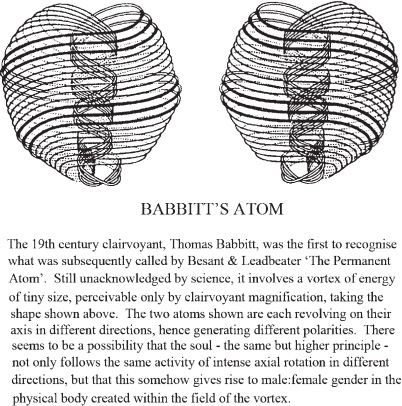
Fig. 1.7. Babbit’s atom
It is perhaps curious that our modern science acknowledges the fact of the spheroidally based cell as the primordial organism in the objective body of a plant, animal, or human, yet solidly refuses to even contemplate the idea that the very same principle might have its own higher and lower counterparts. But cells—which multiply from themselves not unlike the flame of a fire—must themselves originate from germs in a sympathetic environment (i.e., a “culture”) in order to survive. The ancient philosophical and metaphysical traditions unequivocally recognized all this to be so, even if they did not describe it in modern scientific terms.
For example, Pythagoras (see fig. 1.8) held that the Monad (i.e., the metaphysical sphere or field of being that corresponds with the Higher Mind principle animating the lesser soul principle)—and later referred to as the “Indefinite Dyad”—was (like the germ) the self-emanated, causal originator of all objective existence, without having any objective existence itself. Yet every field of objective existence contained within itself a septenary constitution; hence the Hermetic “as above, so below” principle. In addition, geometrical relationships between a given number of macrocosmic points (i.e., celestial souls or stars) had to be considered by reference to the interactively rotating fields of limitation in which they existed.
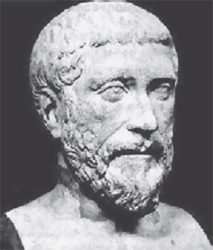
Fig. 1.8. Pythagoras
The more modern philosopher and mathematician Wilhelm Leibnitz (1646–1716) (see fig. 1.9) concentrated on the emanating points themselves, also seeing them as “living essences,” which acted as the agents (as either window or mirror) of the mind, but he did so without taking the axially rotating soul sphere into his philosophical considerations. These points—his “living monads”—had previously been described by Pythagoras under the generic term monas, which was actually derived by him, while in Babylonia, from the Sanskrit term manas, meaning (a “spark” of) Mind.
Modern academic researchers of ancient mathematical philosophy have consistently failed to recognize this fundamental basis of hylozoistic philosophy. So how do we go about proving the issue? Can it be done in a manner that will satisfy scientific or other rational criteria? Well, with the rather arbitrary limitations which modern science seeks to impose upon experimentation—that is, the need to work under unnatural laboratory conditions—this would never be straightforward. We must therefore look to ancillary approaches, recognizing—as some scientists already do—that cross-corroborated psychological experience alone (without technological support or intervention) is a valid field of scientific research. In other words, we must apply forms of ruthless self-discipline to our own subjective experiences and then cross-examine these with those of others. This is already being done in a somewhat restricted manner in the fields of psychology and parapsychology, although neither of these has as yet recognized as such the existence of deva and elemental nature—which we shall deal with in chapter 3.
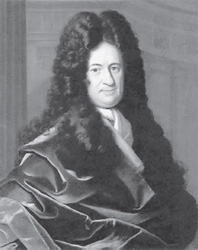
Fig. 1.9. Wilhelm Leibnitz
PLANES AND SUBPLANES OF EXPERIENCE AND FACULTY
Let us remember that every level works according to the Macrocosm–microcosm relationship principle. At the outset a celestial entity (the Logos*7) emanates its Oversoul, the vehicle of the “Demiurge,” a group entity that we shall explain and deal with in greater detail later on. From this a spectrum of yet lesser soul hierarchies are then emanated. Thus, we might suggest, the demiurgic Oversoul of the solar scheme (known as the Aeon) provides the hierarchical groups of what we call “Spiritual Souls,” whereas the planetary Oversoul and Demiurge provides the many hierarchies of “terrestrial souls.” These, in turn, give rise to all the various forms of the kingdoms of Nature on Earth. From each of these Oversouls and souls a vast range of spirits then circulate within the solar and planetary system, so giving rise to all their characteristic functions and ranges of consciousness.
Thus each soul organism is the emanated offspring of a yet greater Oversoul, which is what enables the soul entity to generate what we call the sense of self. The soul entity contains a restricted field of awareness and function—hence its characteristic consciousness, but it is the human “spark” inseminated within the terrestrial soul nature (from a yet higher soul) that endeavors to cause the expansion of that field. That first impulse toward expansion is generated by sensitivity to external influences. This results in desire for reexperience; hence the auric area immediately surrounding the terrestrial soul becomes progressively conditioned by that same quality of desire-energy. This then develops the “astral” or “feeling” function, which otherwise acts as the sensory awareness of the animal nature. However, by virtue of its further, subjective orientation in the human (which the animal has not yet developed*8), it evolves into the human phenomenon of the astral “e-motions,” or outwardly sensory emanations.
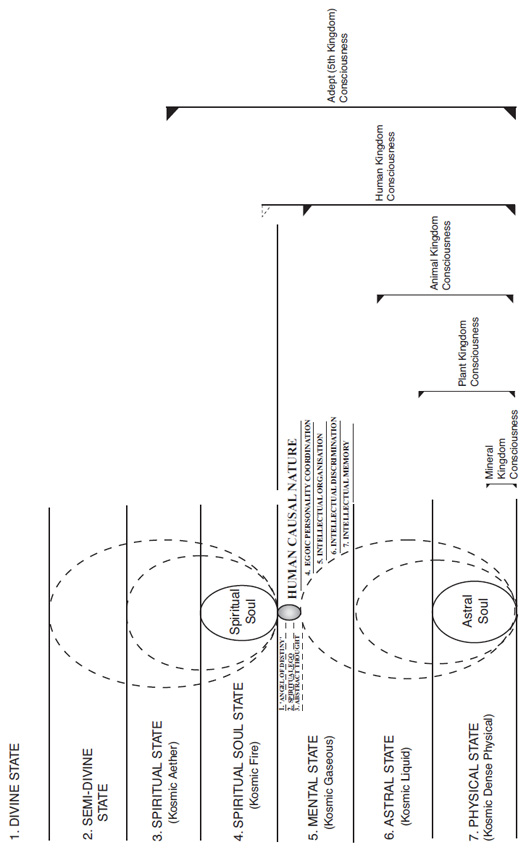
Fig. 1.10. Ranges of consciousness in the kingdoms of nature
From a metaphysical viewpoint, today’s less well developed humanity only uses the grosser matter of the astral soul field, that is, the emotions, in its subjective workings. The lowest two levels or substates of this comprise a reactive emotional nature and acquisitive personal desires, which lead to an idolistic or fetishistic nature. The third and fourth levels then comprise the personal and impersonal ambitious senses respectively; the fifth level comprising the idealistic nature. More developed types progressively add to this the various qualities of the four lower subplanes of the mental state—that is, egoic personality coordination and intellectual organization, discrimination, and memory—usually in conjunction with matter of the astral-emotional state. That thereby generates slightly higher or subtler forms of the same trinity involving idolism, ambition, and idealism.
This same usage of subtler quality subjective matter by more developed individuals derives from the unconscious polarization of self-association with the yet higher spiritual nature. That, in turn, gives rise to the mystic and religious frame of mind, which is, however, largely psychic in nature. That purely psychic orientation is nevertheless now changing due to the formal recognition of the distinction between the Higher Self and the lower self by transpersonal psychology, pioneered by Abraham Maslow and Roberto Assagioli.
The gradual outward projection of astral energies in the practical experience of a human being generates residual memory-forces—hence the base nature of what we may call the “lower mind.” The latter then forms the next auric subfield. The increasingly intelligent manipulation of those memories then, in turn, generates a general sense of organization, the second of the lower mind faculties. That then leads to a sense of the need to organize these distinctively different memories into recognizable categories for potential re-use; hence intelligently analytical discrimination forms the third of the lower mental faculties. Finally (at the present stage of highly developed human evolution) there is derived the fourth lower mental category and capacity. This involves actively intelligent coordination and control of all the so far developed subjective faculties, which coordination thereby forms the basis of what we call the human personality. That, however, is as far as the lesser (terrestrial) soul develops. We shall deal with this again in further detail in later chapters of the book.
All these qualitatively different categories of elemental (astral and mental) substance—although intermingling with each other in the objective and subjective nature of the human being—are thus metaphysically described by modern theosophy as hermeneutically structured, in graded subplanes or substates. These are of immense importance and are in accord with a recurrently underlying sevenfold principle, for reasons also to be described later on. This same principle was known of in Plato’s time—and long before that too.
We human beings (although mostly unconsciously) then choose and use amounts of such substance as is deemed necessary for each subjective task, just as we unconsciously use specific muscles for each objective task. If this approach is kept in mind, the student of the subject will not go far wrong. The current tendency, however, is for people to have a merely static concept of the hermeneutic structure. In practice, this is largely useless. That is because it separates the objective and subjectively theophanic perceptions. These, as suggested from the outset, need to be involved in working together, rather than apart, simply because the purely intellectual viewpoint—in modern scientific terms—causes disintegration of the wave flow.
THE DIFFERENTIATION OF HIGHER AND LOWER MIND
As suggested earlier, the principle of Mind involves an emanation from one field or state of consciousness into another. Thus within the purely human experience, the downward emanation of the human Causal (semi-spiritual) Soul generates the field of the “Higher Mind.” Correspondingly, the upward emanation of the terrestrial soul nature generates first of all the emotional nature and then the “lower mind” faculty. It is then the problem of the individual to bring about a harmony between these Higher Mind and lower mind aspects in order to enable the uninterrupted downflow of higher soul consciousness straight into the physical brain via the limpidly expectant terrestrial soul. However, both the higher and lower Mind emanations involve substates and associated subfunctions amounting to a septenate—four in the higher and three in the lower, as shown in the Pythagorean system defining the Quadrivium and Trivium (see fig. 1.11). The sequentially progressive nature and quality of each substate is quite different, as will be explained in rather greater detail later on.
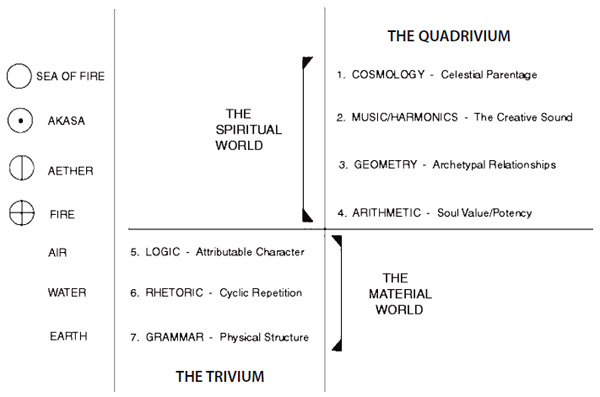
Fig. 1.11. The seven liberal arts and sciences in relation to metaphysics
The expansion of human consciousness in the mass of humanity has, so far, extended to include the four lower mental substates shown in fig. 1.10, although without bringing them under firm control. That is the next stage, leading to full coordination of what we call “the integrated personality.” Further developed humanity then begins to become psycho-spiritually aware of something beyond even this. That “something” involves a fifth mental substate consisting of a completely different quality of matter, derived (as explained above) by downward emanation from the next higher soul organism. This “causal” state we would associate with the generation of abstract mental forms, or archetypes. These are necessarily interdisciplinary in nature and highly ethereal in form. They are also extremely volatile and thus very difficult to work with. Consequently, a truly self-disciplined and highly sensitive human nature is required to be able to perceive or control matter of this fifth mental subplane.
However, the vast majority of human beings are as yet wholly incapable of even approaching that capacity. The reason that this is so derives from the fact that such perception and control comes from an instinctive sensitivity to the nature of the next higher soul organism, which itself controls all activity of higher mental subplane matter. Consequently, in order to achieve this, the individual’s self-polarization has to turn completely about. It must now reorient itself to function from the higher to the lower and no longer upward from the selfish terrestrial soul nature.
As each soul entity is but a partial emanation or projection of a far greater parent soul, in order to access any higher consciousness, it is quite logical that the orientation of awareness must first change in the same way. We can then better understand (as Plato reminds us) why “all learning is nothing but recollection.”22 The omniverse is the playground of a perennially active and emanating Universal Consciousness, the progressively higher reaches of which can only be accessed gradually and sequentially by a process of subliminal sensitivity and reassimilation, in other words, through subjective contemplation.
Rather interestingly, recalling what has already been mentioned regarding his view from the perspective of “quantum yoga,” Amit Goswami believes in “upward causation and continuous change” on the one hand and, in addition, “downward causation as consciousness collapses the possibility wave into an event.”23 From the viewpoint of esotericism the former involves merely karmic action, that is, action derived from sensory reaction (which is not actually causal), whereas the latter involves dharmic action, that is, purposeful action derived from higher soul consciousness. That, however, leads on logically and sequentially to our next point, as follows.
The scientist Bruce Lipton—although concerning himself largely with cellular development and evolution—has a rather interestingly occult view on his own field. Showing how the genetic determinism of Crick and Watson (although still widely accepted) has been completely disproved by science itself in the field of epigenetics, he otherwise describes how environmental influences conditioned by our own personal attitudes of mind are actually the true determining factors behind all cellular change in the human organism.24 Recognizing also that consciousness exists outside the body—hence the telepathically morphic field theory of Rupert Sheldrake—he too is of the belief that the surrounding “field” is of the most crucial importance as a transceiver of information or knowledge, circulating within a given “horizontal” continuum.25
However, while also making clear his perception that the human mind is very capable of transmitting commands that the cell or cellular groups will obey, thereby effecting all sorts of biochemical change, he does not take into consideration the interface of the terrestrial soul, or of the etheric double. The esotericist and occultist, on the other hand, both recognize that these sequential interfaces are themselves the main “environmental” determinants.
THE NATURE AND STRUCTURE OF THE SOUL AURA
Within the terrestrial soul field, there is a light-filled aura, a literal web of psychic force interpenetrating and extending beyond the body of the human organism. This is as well known to clairvoyants as is that surrounding the cell, the latter having been made visible to us all through the agency of the electron microscope. In order to answer the question as to why it appears as it does, let us look at the situation rather more sequentially as follows.
First of all, meditative contemplation confirms that knowledge is contained in the outer auric envelope of the soul (the latter being paralleled by the “brane” of quantum science and the “event horizon” of astrophysics, as we saw earlier), expressing itself in the form of subtle vibration. Hence the same might be said of the cell. This is due to the fact that the outer membrane of the cell is highly sensitive and in a state of constant tension, as can to some extent be seen using an electron microscope. In addition, science already acknowledges that it is the outer plasm of the cell (hence also that of the soul) that contains its memory and driving mechanism.
In other words, the nucleus is secondary to the outer membrane; it is not primary or causal. Yet we still tend to think of the center of anything as being causal, with everything else gathered around it. This, however, is a fallacy based upon pure misinterpretation, through following the Aristotelian method of reductive analysis. Yet both clairvoyants and scientists are equally uncertain as to the real nature of these phenomena. There is a general ignorance about what constitutes the fundamental difference between the outer plasmic membrane and the inner plasm (the cytoplasm) of the cell, which may or may not contain a nucleolus.
What is it then about the cellular membrane of the atom, the cell, and the soul that thus gives it its faculty of coherence and instinctive knowledge? What also causes so many of them to rotate around their own axis? The very same question could be asked by the astrophysicist contemplating the fields surrounding each galaxy. These somehow manage to contain all of the galaxy’s constituent dark matter and dark energy, thereby arresting them from being centrifugally ejected into outer space, as the world of astrophysics has already acknowledged. But how and why? The answer to the question in both cases lies in yet another completely misunderstood word—Mind.
THE TRUE NATURE OF MIND
From the viewpoint of occult science and metaphysical philosophy, spirit, matter, and energy are one and the same in essence, although periodically presenting themselves phenomenally as one or another of these. The same happens with energy and force in the objective world, in accordance with relativity theory. Yet the same philosophical tradition puzzlingly states that the spirit (or monadic life-essence) is everywhere and nowhere at the same time, that it exists and yet does not, that it is no-thing but yet gives rise by self-emanation to all phenomenal existence, of which it is itself the germ. By virtue of its primordial nature, preexisting that of even the soul, what then is it? And what does the soul itself then comprise?
It follows quite logically that if, in the beginning, there is/was nothing but spirit (this being the substance of the universal nous), soul must itself be composed of it. Indeed, this is perfectly in accord with the ancient wisdom tradition. Thus the cystic or auric periphery of the cell’s or soul’s field must itself be composed of spirit-matter in some or other form of coherent interrelationship with itself.
It is thus the “spark” of spirit—the germinal no-thing (the Pythagorean monas and the monad of Leibnitz)—that essentially provides the causal nature of soul-consciousness by virtue of some kind of mutually sympathetic group activity. That same activity must then necessarily comprise or involve a coherently sympathetic vibration, which results in the generation of mutually self-constricting wave patterns. It is these latter wave-fields, one might suggest, that then combine to produce the outer membrane, the peripheral field that in esotericism is known as the “ring-pass-not,” thereby engendering the cell or soul entity. Hence Plato tells us very graphically that the human body is carried about by us “like an oyster in its shell.”26
With that in consideration we might then ask what causes this apparently self-containing activity that results in the formation of an outer membrane? The answer to this lies in what H. P. Blavatsky described as “Fohat [the dynamic electricity of Mind] digging holes in Space.”27 Hence also the often-repeated gnostic principle that the universe is concentrically organized.28 That is to say, as already indicated, each soul entity is the offspring of a parent soul, or Oversoul, that contains it. That containment results from the inward or centripetal emanation of the Oversoul, which we call the descending “Mind” principle. Thus the Mind itself is effectively that intelligent force, which generates and contains the lesser soul in a sort of vortex (referred to by the ancients as a “whirlwind”) through a form of electromagnetic containment and then impregnates it with its own higher essences. As the early theurgical philosopher Iamblichus comments: “For Soul is brought to completion by intellect [Mind] and Nature by soul.”29
SOME ANCIENT CORRESPONDENCES
The ancient Greeks explained the generation of the lesser soul by the Mind allegorically in the story of the Titan god Ouranos, a name derived from the compound aura-nous—meaning the “sphere of celestial Mind.” Ouranos thus enfolds the Titan goddess Gaia (Gaia being a portion of Space itself, not Earth as commonly misinterpreted) within his mighty embrace. He then forces himself upon her “sexually,” emanating the Eros principle, thereby causing her to become pregnant with six pairs of lesser Titan gods and goddesses, all of whom are described as (titanic) “forces in Nature” rather than discrete entities. The actual essence of what is being described here is that the Mind—emanating from the higher and purposeful Intelligence—separates and thus contains a field of space within the overall field of Universal Consciousness and then, within this, generates creative activity. (This is also precisely what we humans do when we “think.”)
In the first few verses of the biblical Book of Genesis, shared by Jews, Christians, and Moslems alike, exactly the same principle in the Macrocosm is described, albeit in a slightly different way. Here the Elohim (the hierarchies of the Demiurge known in Hindu philosophy as Dhyani Chohans and in Christian terms as archangels) separate the “waters (of space) above” from the “waters (of space) below,” thereby generating a spheroidal “firmament,” which they then turn into a heaven world. From this all the germs of life in the various kingdoms of Nature are then made to emanate in due cycle into the field of containment thus formed.
The kabbalistic Zohar follows exactly the same line in the definitive statement:
One is the source of the sea. A current comes forth from it making a revolution which is Yod [the first letter in the name of God]. The Source is one and the current makes two. Then is formed the vast basin known as the sea, which is like a channel dug in the earth and it is filled by the water issuing from the Source. This vast basin is divided up into seven channels.30
In fact, Kabbala refers to the Source as Keter and the primary emanation as Hokmah (perhaps meaning “true magic”) or Chokmah (a phonetic corruption of the ancient compound Shu-Kumar, meaning “divine virgin light”). Binah (derived from ben-Yah, that is, “son of Yah”) is then the great “sea”—that is, the Oversoul—containing the lesser seven. Later Lurianic Kabbala (conceived by its founder Isaac Luria in Egypt) tells us exactly the same thing. It does so by describing how the Deity limits itself by a creative process called tzimzum, thereby generating a second Creator-God (the Demiurge or Oversoul). The latter then emanates all the seed-essences of the world-to-be out of itself. The Greco-Egyptian literary work Hermetica31 correspondingly tells us that:
The Mind who is God, being androgyne and existing as life and light, by speaking gave birth to a second mind, a Craftsman who, as god of fire and spirit, crafted seven governors; they encompass the sensible world in circles and their government is called Fate.
The neo-Pythagorean philosopher Iamblichus also confirms that: “Soul is defined by the divine principle of limit, and participates in this in a partial mode.”32
Yet another example, which takes into account all the various aspects just mentioned involves the emblematic metaphor known as the sacred Tibetan “Wheel of the Law” (see fig. 1.12), described by Evans-Wentz as: “The eight-spoked Wheel on a lotus throne and enhaloed by Flames of Wisdom . . . symbol of the symmetry and completeness of the Sacred Law of the Dharma.”33 In relation to the ten characteristics thus described, drawing a direct parallel with kabbalism, the lotus throne is akin to Keter, the enfolding flames of wisdom to Chokma (or Hokmah) and the eight-spoked wheel to Binah, the Oversoul of Creation, or Demiurge.

Fig. 1.12. Tibetan Wheel of the Law
It is otherwise worth mentioning in passing the parallel Hindu symbol of the god Siva Natarajah (see fig. 1.13) with his six limbs (seven including his head), dancing on the waters of space, surrounded by the sacred flames of the great god Agni. He and his six limbs constitute an esoteric heptad, while the halo of flames constitutes the enfolding Ogdoad of the yet greater divine Mind, of which the rest are but partial and temporary expressions.
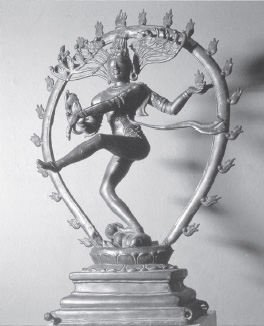
Fig. 1.13. Siva Natarajah
THE UNIVERSAL PRINCIPLE OF “DIVIDE AND RULE”
One could go on almost endlessly justifying what has just been stated here by citing the different allegories of Creation in all the ancient traditions. However, in every case, without exception, the gnostic principle follows exactly the same course, in which Creation is caused by the self-limitation of kosmic consciousness, thereby creating a celestial Oversoul. This is then followed by a segmentation of that field into seven lesser fields or states; following precisely the same principle, the human is the microcosm of the Macrocosm. As our neo-Pythagorean friend Iamblichus again comments:
It is by the action of the superior beings that the inferior are produced, by the action of the incorporeal that bodies are produced, and by the action of creative forces that there are produced objects and they are given guidance through their all-embracing direction.34
This is, of course, yet again in direct contrast to modern scientific orthodoxy. The latter still holds to the irrational idea that matter coming together in molecular form by pure chance eventually gives rise to simple organic and then coherently complex biological forms, which eventually generate consciousness and intelligence out of their combined range of experience. This has been amusingly described as akin to the rather ludicrous suggestion that given enough monkeys with enough typewriters and enough time, one might expect the works of Shakespeare to be produced by them.
We thus return to the issue of what exactly comprises the internal field of the soul/cell. This might be described as a generalized, protoplasmic substance, “captured” from the mass of what the nineteenth-century magus Eliphas Levi (1810–1875) (see fig. 1.14) called the “astral light” of the planet.35 It is this underlying plasmic “ether” (as yet still not accepted by modern mainstream science, although often referred to as “dark matter”) that subtends (and also preexists) the gaseous atmosphere of the planet. It is then electrically magnetized by the polarity induced in it through the constriction of the cell by the enfolding Mind principle, which “descends from above.” The result is equivalent to the piezo-electric effect induced in a crystal when squeezed.
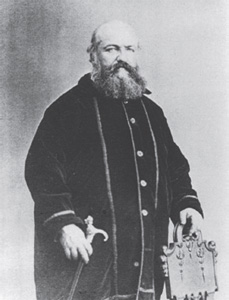
Fig. 1.14. Eliphas Levi
It is as a result of this electromagnetic induction that the captured matter is further induced to generate forms out of itself. These are then coordinated to produce a single visual organism, as evidenced in the scientist’s use of a cathode ray tube or holographic projection. This same principle applies in the microcosm, the macrocosm, and the yet greater Macrocosm, these being respectively known in theosophical terms as the astral light, the Buddhi, and the Maha-Buddhi, the latter Sanskrit term also otherwise being known as Mahat.36 H. P. Blavatsky tells us of the ancient tradition that this was the first stage of proto-human development on this planet (something which is further detailed in appendix A at the back of this book) a concept correspondingly described by Plato. He openly referred to the first men as being “spheroidal in shape and fiercely ambitious,”37 only later developing the complex biological form with which we are familiar today.
PLATO’S CAVE
While mentioning Plato again, it is interesting to note here his analogy of the cave38 in which the mere shadows of sunlight or firelight thrown upon the cave’s internal walls are taken for reality by those living within it, with their backs to the cave entrance. The “cave” is itself an esoteric metaphor describing the internal enclosure of the terrestrial soul organism within which the human experience takes place. However, keeping in mind that the real light is emanating from outside the “cave,” that is, from above, we can readily understand why a form of magnetic polarity should be involved in the organism by virtue of its relationship with its own parental source. That is to say, the parent Oversoul contains the lesser soul within itself, its own electrical emanation being what we like to call the Mind principle, as earlier described.
The Mind principle is projected like a sort of electrified coil of living essence that enfolds a field of space like an aura (derived from Ouranos/Aura-Nous) for purposes of ideation, but which can be withdrawn from this activity by the Oversoul at any time. Rather like the string of the puppeteer, the controlling influence of this “coil” is to be found at the upper or “northern” pole of the auric soul field (the “cave entrance”) where there exists a depression caused by the vortex of force being drawn down into the field, as described in Babitt’s atom (see again fig. 1.7). The congruence of Oversoul energy and soul-matter to be found in this area generates a very real and fiery light, one that gradually irradiates the brain consciousness with insights and intuitions according to the invocative focus of interest to be found there. This too we shall deal with in greater detail somewhat later on.
The principle involved here is already well known to physics: energy imposed upon a captured field of inertia gives rise first of all to vibration, then to heat, and then to light. The generalized ethereal substance “captured” by the soul body is itself a field of relatively material inertia, as already described. Hence, when made to vibrate, this merely generates a generalized awareness to begin with. However, when this constraint is intensified, the localized consciousness of the individual (in the heart chakra or center), when first exposed to a higher influence, responds by generating heat—that is, highly emotional (i.e., “astral”) passion with a mass of associated colors.
The individual’s impressions and responsive reactions are initially more full of heat and color than light. However, this gradually changes through further experience and imposed crises of decision forcing the person to learn self-discipline. That in turn leads progressively to the appearance of an illuminating and then discriminating sense of reasonableness. Hence it is that compassionate tolerance is a characteristic associated with the heart. That same faculty eventually leads to a subjective reorientation to the consciousness of the crown chakra with its range of influence on the human brain, particularly via the brow and occipital subchakras.
THE APPEARANCE OF SELF
The preliminary effects of this psychological evolution is that the soul entity is made to generate two secondary fields of qualitatively personalized consciousness around it, as earlier described. The first of these fields contains energy and force conditioned by personal sensitivity, giving rise in the human case to the formation of reactive desires and ideals. This constitutes the individual’s emotional world. The second field—that of the “concrete” or form-building mind—contains energies and forces involving more coherent and longer lasting personal memories of both a “good” and a “bad” nature. Both these aurically enfolding fields then progressively tend to “fill up” with the elemental condensate of the forces thus generated. That thereby creates a further densification through which the higher (that is, spiritual) energies have to penetrate to have any real effect on what lies below.
This perhaps aids in understanding the logic of the ancient tradition that humankind was originally much more naturally “spiritual” in its consciousness—that is, when the two outer fields (the Oversoul and the lesser soul) were still in the early stages of development and coordination. It was only as human beings became more self-concerned that the two outer fields joined together in producing within human nature a progressively more defined persona and associated sense of individuality. This self-centeredness was an inevitable outcome of the evolutionary process and of course it led to (and still leads to) all sorts of iniquity as a result of latent elemental influences stored up in the lesser auric memory of the terrestrial soul, impelling the physical human entity to behave in certain rather animalistic ways.
It is perhaps easier for us to understand this process in terms of the colors that the clairvoyant sees in the aura of the individual. The inherent vibratory quality imposed upon matter by any particular energy will result in an aggregation of force with an attendant color and hue, plus a characteristic intensity (or lack of it). A grosser desire or experience will thus inevitably lead to darker, murkier colors being generated, while less self-centered mental or emotional activity will produce much lighter colors and far less in the way of psychic condensate. Thus, in the case of the less self-centered, there will be a far more prolific response to incoming spiritual energies. However, with those who are less experienced in discriminating the qualities and forces inherent in the incoming energies, desire and the mind faculty tend very quickly to become overenergized and thus subject to psychic illusion. It becomes very easy for them to become carried away with a light-filled imagery, which is actually only psychic and not of a truly spiritual nature at all.
MYSTICISM AND THE FACULTY OF SIGHT
It is this latter type of situation that leads to one type of mysticism. In this, to begin with, because of the tremendous sense of expansion and power thus occultly experienced, the individual very easily feels in tune with what is assumed to be God or the archangels/angels, or even at-one with the Universal Mind. No amount of rationalizing will persuade the person to the contrary; in fact, the apparently very wondrous nature of the subjective experience will, when recounted, tend to lead others into the trap of devotional adulation or supposedly spiritual hero-worship that has no real justification at all. This is endemic in the Roman Catholic Church in terms of the so-called “beatification” of individuals of the same faith in order to approve them as “saints.” That is, in fact, a brilliant political device for the church’s own self-existence, as well as ensuring its own political control over the laity.
From the occult viewpoint, however, it follows quite logically that the true types of spiritual training associated with real initiation concern themselves first and foremost with teaching the individual how to use the intelligence to recognize these pitfalls and, eventually, how to avoid their self-creation altogether. As we shall see later on, it is this that enables the true spiritual vision to develop as a very real faculty within the individual’s nature, leading to a progressively more reliable inner illumination.
It might also be worthwhile mentioning here what Plato had to say about the question of light, bearing in mind what has already been suggested about the correlations between light and the spiritual fire that forms the apparent “body” of the soul. He tells us first of all that fire is of several types39 (esoterically there should be seven) and that one of these involves a nonburning radiance or “pure fire,” which emanates from within the soul of the individual outward through the eyes, this being essentially of the same nature as that of sight, along which the stream from within strikes the external object.
[Thus] the whole so formed is homogeneous and the motions caused by the stream coming into contact with an object or an object coming into contact with the stream penetrate right through the body and produce in the soul the sensation which we call sight. But when the kindred force disappears at nightfall, the visual stream is cut off.40
What Plato is actually saying involves the basic occult principle that only like recognizes like in complementary fashion, for all essential qualities of matter. Hence, because the inner spiritual being is essentially a solar entity, the emanations of the two must fuse to some degree before a given faculty becomes apparent in a particular state. Vision is ever the third faculty to be developed—after hearing and touch—hence it is that we find the faculty and organs of sight first manifestly apparent in the third kingdom in Nature, the animal. However, the human—the fourth kingdom in Nature—then adapts this faculty and turns it inward. That generates the subjective vision that we call “imagination,” plus the “mind’s eye,” with an associated ability to produce conscious memory. This the animal entirely lacks, although astral vision in some animals is apparent in a very rudimentary and unconscious state.
It is also important to be aware that the psychic condensates generated by human imagination and memory not only block the incoming spiritual influences but at times also cause them to be refracted—like light passing through a crystal or water—or reflected. As a consequence, they give rise to all sorts of distortions, literally “bouncing” off the walls of the soul aura in question. This, in passing, points to the way in which the visual faculty itself works—something which science again believes it understands but which it actually does not.
The faculty of physical sight, perhaps curiously, works essentially through soul faculty, not—as science teaches us—because of sunlight or artificial light passing through the pupil and retina, causing a biochemical reaction in the rods and cones at the rear of the eyeball, which then transfers itself to the brain. Instead—because of the internal light-energy generated by the soul (known to Platonists as “the single eye”)—the human eye actually projects outward a beam of invisible light that comprises five streams of force41 of which modern science yet again knows nothing. It is this very principle that has given rise to fears of “the evil eye” on the part of peasant or native communities, who are much more in natural tune with psychic phenomena than city or town-bred folk who have learned to distrust what they believe to be the mere absurdity of folklore.
It is this same principle of a psychic “lever” that, when properly harnessed by simply (occultly) altering the attitude of mind in a certain way, enables some people to be “natural” hypnotists. It is again this that causes people, usually inadvertently, to attract the attention of others by merely staring at them. However, what is not generally realized is that a higher psycho-spiritual influence is involved and that the coordinated energies from two chakras are being used to project it. We might add the suggestion that it is because of these two chakras that the animal organism of the human body has two eyes.
THE PHENOMENON OF LIGHT
We might otherwise suggest that physical sight actually works as much through the agency of the iris as it does through the pupil and retina. That is because every external form has an accompanying etheric “shadow.” But to explain this we first need to explain one or two other things that are not quite as they appear, or as we have been taught. The first of these is that there is no such thing as “sunlight” per se. The sun at the center of our solar system does not itself generate light, but only a highly powered energy; when that energy comes into contact with our Earth’s atmosphere, it causes it to vibrate intensely and thus generate light out of itself. Even this, however, is a simplification of what actually happens, because different types or qualities of solar radiation are due to the auxiliary assistance of other influences.
To recapitulate what was explained earlier: the Earth possesses its own Oversoul, which contains, by entrapment, a field of chaotically unorganized ethereal substance (from solar space), which is known to occult science as “the astral light”—a term first used, as mentioned earlier, by the nineteenth century occultist Eliphas Levi. This substance—otherwise known as the Earth’s etheric double, which is a lower correspondence to the Buddhi (the kosmic etheric double)—underlies the gaseous and watery atmosphere of the planet, these being merely its condensates. This ethereal double is a sort of plasma, an invisible mass of subtle matter carrying a latent electrical energy of a particular quality and force, rather like a battery solution.
This latter solution is constantly reenergized by solar activity, sometimes even becoming overcharged and causing all sorts of technical problems to modern electronic equipment. It is also charged by what we would today call “gravity” and “levity,” two (fundamentally similar) forces generated by the core of the Earth and the ionosphere respectively, although mainstream science has not yet quite recognized how and why. The electromagnetic “loops” seen emanating from the Sun’s surface give some idea as to the former, for “gravity” is merely the returning energy (hence the limitation of its objective force, as noted by modern science), which originally emanated from the core of the celestial body, as I have suggested in previous books.
The individual human being, by possessing a terrestrial (or “astral”) soul organism derived from the planetary Oversoul, also contains, by entrapment within its auric field, a proportion of astral light. This the human soul “personalizes” and uses to generate and maintain a physical body of incredibly complex organization. Consequently, it is the interaction between the soul, the etheric double, and the physical body that enables the human being actually to exist and survive. But this is not the whole of the story, because what we have described so far merely involves the intermediate psychic nature of the human being. The spiritual nature, which gives humankind the faculty of self-consciousness, is something quite distinctively greater, derived from the fact that the inner person is a solar being, working within the kosmic etheric double of the Logos.
CONCERNING ANGELS AND DEVAS
We shall deal rather more fully with the subject of angels and devas in chapter 3 where we shall see how and why they are fundamental to this same subject of consciousness. However, a few preliminary remarks at this point should be useful in correlating the human soul nature with that of the deva, or angel. Devas—a hierarchy of being that is complementary to the human—are essentially the partial and localized expression of Universal Memory, while the soul is itself the container of a necessarily limited field of knowledge (as light), a holographic fragment of the Universal Memory. It is then the concentric nature of the soul principle, which we have already described, that enables the macrocosmically “local” containment of consciousness throughout the universe through the agency of a celestial being known as an “Aeon.” This, in unfolding its own essential nature as a sequential stream of reexpressed memory through a cycle of manifestation, is itself neither beginning nor end, but both.42 Hence the consciousness of the Aeon and infinity are essentially synonymous terms.
An “infinity,” it should thus be noted, merely signifies a celestially localized perfection or limitation of Universal Memory innate in the nature of a kosmic organism. The aeonic “body” itself comprises the Oversoul of whatever celestial organism is under consideration. Any transfer from this entity to a lesser entity then occurs as a result of groups of spirits (previously contained within the peripheral membrane of the Oversoul in question) “descending” to a lower sphere of being in order to impose upon it the will and purpose of the higher Oversoul entity. Hence it is that we have the purely allegorical story of the “fallen angel,” found in so many different religions throughout the world.
Higher beings require “vehicles” of a lower order in order to take up a phenomenal existence in the lower world scheme in order to effect their duty, in pursuit of logoic Purpose; hence it is that individual spirits of a higher order are forced to incarnate in (or through) lesser soul organisms in order to carry out their appointed tasks in the pursuit of that same higher Purpose. According to the ancient traditions, where such a situation arises, there we find the human being. But what then is the soul organism that does not contain this higher “spark”? And what is its purpose in the general scheme of things?
This other type of soul organism (or rather, its “bodily expression”) is what ancient tradition has made known to us as that of the “angel” or “deva”; its predominant subjective characteristic is that it possesses a distinct range of knowledge and faculty but has no sense of choice or alternative. Its consciousness is completely instinctual, although highly intelligent—far more directly so than that of the human, even in the higher reaches of the latter’s mundane social hierarchy. The sole concern of the angel/deva—often mistakenly known as a “nature spirit”—is the perfect reproduction of the “divine plan” in the mind of its parent Oversoul. It might thus be considered in the mass as the instinctual “memory” of the Macrocosm or Logos—that which maintains the “status quo.” The human, on the other hand, may be described as the lesser agent of the imagination of the higher Logos (and is thus the instigator of all change in the kosmos)—hence the Macrocosm–microcosm relationship to which we constantly refer. This idea will perhaps be more easily understood as we deal rather more specifically with human consciousness in the next chapter. Of that the Hermetica has this to say by way of an introduction to the idea of an emanating higher consciousness “ensouling” a lesser one.
The Mind cannot naked and alone take up its abode in an earthy body; a body of earth could not endure the presence of that mighty and immortal being, nor could so great a power submit to contact with a body defiled by passion. And so the Mind takes to itself the soul for a wrap.43